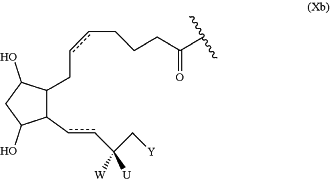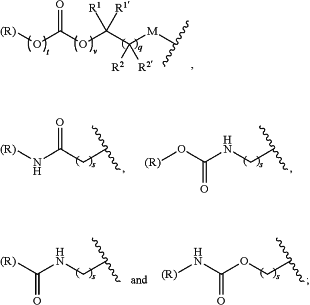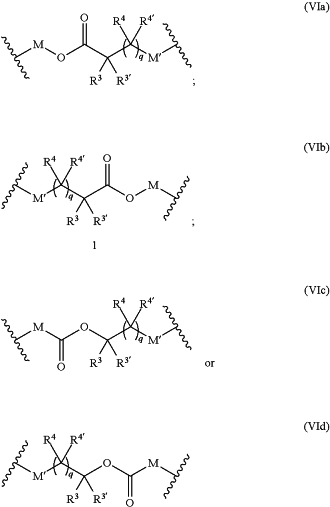| CPC C08G 73/08 (2013.01) [A61K 31/5377 (2013.01); A61K 31/5575 (2013.01); A61K 47/59 (2017.08)] | 20 Claims |
|
1. A drug-polymer conjugate, which is a copolymer of (i) at least one monomer of Formula (I):
 where:
X may be the same or different at each occurrence and represents a terminal functional group comprising an alkyne or an azide;
R is selected from the group consisting of linear or branched hydrocarbon, optionally substituted aryl and optionally substituted heteroaryl;
D is a releasable drug selected from a prostaglandin analogue according to Formula Xb:
 wherein:
 represents the point of attachment of the prostaglandin analogue to linker group L; represents the point of attachment of the prostaglandin analogue to linker group L; represents a double or single bond; represents a double or single bond;Y is optionally substituted C4 to C10 hydrocarbyl or optionally substituted C4 to C10 hydrocarbyloxy; and
W is hydroxy and U is hydrogen, or W and U are both fluoro, or W and U together form oxo;
L is a linker group;
wherein the drug D is conjugated to the polymer backbone via an ester linkage formed between the drug D and the linker group L;
Q is independently selected at each occurrence and may be present or absent;
wherein when present, Q represents a linking group and is selected from the group consisting of:
 wherein
(R) indicates the end of the group attached to the group R and the opposite end is attached to (X);
each of t and v are independently 0 or 1 and at least one of t and v is 1;
R1, R1′, R2 and R2′ are independently selected from the group consisting of hydrogen, alkyl, alkoxy and alkoxyalkyl, and wherein one of the pairs of R1, R1′ and R2, R2′, may between the members of the pair form a carbocycle or heterocycle of 3 to 6 constituent ring members wherein the heterocycle may comprise from 1 to 3 constituent oxygen heteroatom ring members; and
M is selected from the group consisting of a bond, optionally substituted C1 to C10 straight or branched chain aliphatic, the group —O—(C1 to C10 straight or branched chain aliphatic), an ether linking group comprising C1 to C10 straight or branched chain aliphatic interrupted by a oxygen (—O—), the group —N(Rw)—(C1 to C10 straight or branched chain aliphatic) and an amine linking group comprising C1 to C10 straight or branched chain aliphatic interrupted by the group N(Rw) wherein Rw is selected from hydrogen and C1 to C4 alkyl;
q is 0 or 1;
s is from 0 to 10;
and
(ii) at least one co-monomer of Formula (IIIa):
J-((ORa)m—B-A)n (IIIa)
wherein
A may be the same or different at each occurrence and represents a group comprising a terminal functional group comprising an alkyne or an azide functionality, wherein the alkyne or azide functionality in the terminal functional group is complementary to the alkyne or azide functionality in a terminal functional group X present on a monomer of formula (I);
J represents a bond, oxygen or linking functional group,
Ra is selected from ethylene, propylene, butylene and mixtures thereof;
m is 1 to 300;
n is 3 to 8;
B is a bond, oxygen, the group of formula -MOC(O)N(H)M′-, -MOC(O)OM′—, MC(O)NHM′-, the group formula selected from (VIa), (VIb), (VIc) and (VId):
 wherein M and M′ are independently selected from the group consisting of a bond, optionally substituted C1 to C10 straight or branched chain aliphatic, the group —O—(C1 to C10 straight or branched chain aliphatic), an ether linking group comprising C1 to C10 straight or branched chain aliphatic interrupted by a oxygen (—O—), the group —N(Rw)-(C1 to C10 straight or branched chain aliphatic) and an amine linking group comprising C1 to C10 straight or branched chain aliphatic interrupted by the group N(Rw) wherein IV′ is selected from hydrogen and C1 to C4 alkyl;
q is 0 or 1; and
wherein in the monomers of formula, (VIa), (VIb), (VIc) and (VId) the groups R3, R3′, R4 and R4′ are independently selected from the group consisting of hydrogen, alkyl, alkoxy, alkoxy-alkyl, amino, alkyl amino, dialkylamino, amino-alkyl, alkylamino-alkyl, dialkylamino-alkyl wherein one of the pairs of R3, R3′, R4, R4′, may between the members of the pair form a carbocycle or heterocycle of 3 to 6 constituent ring members wherein the heterocycle may comprise from 1 to 3 constituent heteroatom ring members selected from oxygen and nitrogen which nitrogen may optionally be substituted by C1 to C6 alkyl; and
wherein at least one of the groups Q in the monomer of formula (I) and B in the co-monomer of formula (Ma) comprise at least one substituent selected from the group consisting of R1, R1′, R2, R2′, R3, R3′, R4 and R4′ which is present and is not hydrogen.
|